Related Research Articles

Fife is a council area, historic county, registration county and lieutenancy area of Scotland. It is situated between the Firth of Tay and the Firth of Forth, with inland boundaries with Perth and Kinross and Clackmannanshire. By custom it is widely held to have been one of the major Pictish kingdoms, known as Fib, and is still commonly known as the Kingdom of Fife within Scotland. A person from Fife is known as a Fifer. In older documents the county was very occasionally known by the anglicisation Fifeshire.
Cupar is a town, former royal burgh and parish in Fife, Scotland. It lies between Dundee and Glenrothes. According to a 2011 population estimate, Cupar had a population around 9,000, making it the ninth-largest settlement in Fife, and the civil parish a population of 11,183. It is the historic county town of Fife, although the council now sits at Glenrothes.

The University of Dundee is a public research university based in Dundee, Scotland. It was founded as a university college in 1881 with a donation from the prominent Baxter family of textile manufacturers. The institution was, for most of its early existence, a constituent college of the University of St Andrews alongside United College and St Mary's College located in the town of St Andrews itself. Following significant expansion, the University of Dundee gained independent university status by royal charter in 1967 while retaining elements of its ancient heritage and governance structure.

Ceres is a village in Fife, Scotland, located in a small glen approximately 2 miles (3 km) over the Ceres Moor from Cupar and 7 mi (11 km) from St Andrews. The former parish of that name included the settlements of Baldinnie, Chance Inn, Craigrothie, Pitscottie and Tarvit Mill.
Dundee was a constituency of the House of Commons of the Parliament of the United Kingdom from 1832 to 1950, when it was split into Dundee East and Dundee West.
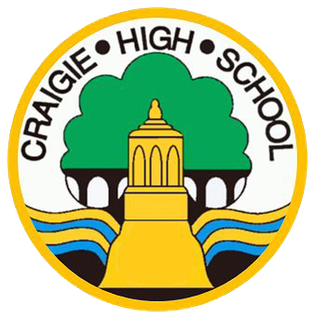
Craigie High School (CHS) is a co-educational government funded High school situated in the city of Dundee, Scotland. The school is located within Craigiebank and has been serving the areas of Craigiebank, Douglas and Pitkerro for over 50 years. It is planned to close in 2025 after a merger between the school and Braeview Academy was confirmed in January 2021.
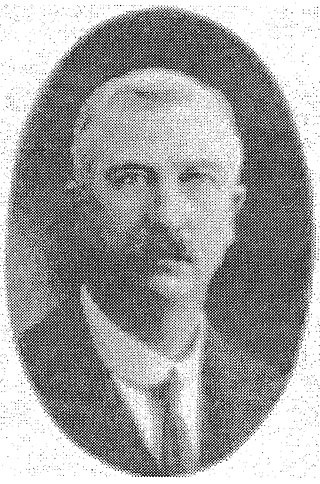
Robert Rivington Pilkington was an Irish politician who sat in the Western Australian Legislative Assembly and the British House of Commons.

William Edward Baxter was a Scottish businessman, Liberal politician and travel writer.
Dundee is the fourth-largest city in Scotland with a population of around 150,000 people. It is situated on the north bank of the Firth of Tay on the east coast of the Central Lowlands of Scotland. The Dundee area has been settled since the Mesolithic with evidence of Pictish habitation beginning in the Iron Age. During the Medieval Era the city became a prominent trading port and was the site of many battles. Throughout the Industrial Revolution, the local jute industry caused the city to grow rapidly. In this period, Dundee also gained prominence due to its marmalade industry and its journalism, giving Dundee its epithet as the city of "jute, jam and journalism".
James Thomson (1852–1927) was the City Engineer, City Architect, and Housing Director of Dundee, Scotland. He originally planned an immense Beaux Arts style Civic Centre covering the centre of Dundee. At the onset of First World War, his plans were scaled down and he retired in 1924.

The rector of the University of Dundee is elected by the matriculated students of the University of Dundee. From 1967 to 2010, the rector was automatically a full member of the University Court. The rector also had the right to appoint an assessor, who was also a full member of the University Court. Following changes made to the university charter in August 2010, the rector must choose to take up full membership of the University Court or appoint an assessor who has full voting rights.
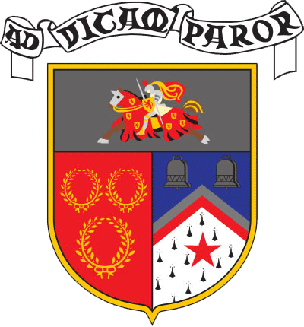
Bell Baxter High School is a non-denominational comprehensive school for 11 to 18-year-olds in Cupar, Fife, Scotland. Founded in 1889, it educates over 1,500 pupils mainly from the surrounding villages.
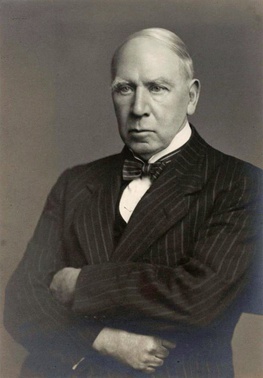
Sir Robert Robertson was a British chemist who served as HM Government's Government Chemist between 1921 and 1936. He was the first person to establish that two types of natural diamond existed.

The Barony of Craigie is a Scottish feudal Crown barony within and near Dundee in Scotland. Craigie has long been incorporated within the boundaries of the Royal Burgh of Dundee; before that it was a barony lying on the periphery of the town.
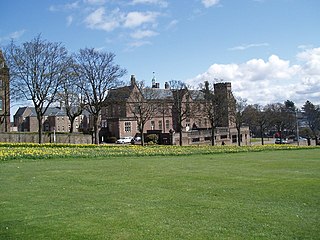
Dundee Royal Infirmary, often shortened to DRI, was a major teaching hospital in Dundee, Scotland. Until the opening of Ninewells Hospital in 1974, Dundee Royal Infirmary was Dundee's main hospital. It was closed in 1998, after 200 years of operation.

Sir David Baxter, 1st Baronet (1793–1872), was a linen manufacturer in Dundee, Scotland, and a baronet. He also performed a considerable amount of philanthropic work, benefiting his home city of Dundee and more widely Scottish education.
Camperdown Works was a jute works in Dundee, Scotland, which covered around 30 acres and at one point employed over 14,000, mostly female, workers. It was for a time the world's largest jute works and was owned by Cox Brothers.

The Royal Dundee Liff Hospital, previously known as Dundee Lunatic Asylum and Dundee Royal Lunatic Asylum, was a mental health facility originally established in 1812 in Dundee, Scotland. It was originally located in premises in Albert Street Dundee, but later moved out of the town to new buildings in the nearby parish of Liff and Benvie. Buildings at Liff included Greystanes House, which was the main building, and, Gowrie House, which was the private patients' facility. Both Grade B listed buildings.

County Buildings is a municipal structure in St Catherine Street in Cupar, Fife, Scotland. The building, which was the meeting place of Fife County Council, is a Category B listed building.
Winston Churchill lost his seat of Dundee in the 1922 general election as a National Liberal follower of David Lloyd George. The election was the only time a challenger standing as a prohibitionist was elected as an MP in the UK.
References
- 1 2 3 4 5 "MS 188 G.L.Wilson Department Store". Archive Services Online Catlogue. University of Dundee. Retrieved 6 September 2017.
- 1 2 3 McKean, Charles; Whatley, Patricia; with Baxter, Kenneth (2013). Lost Dundee. Dundee's lost architectural heritage (2nd ed.). Edinburgh: Birlinn. p. 180. ISBN 978-1-78027-106-4.
- ↑ Wilson, Garnet (1966). The Making of a Lord Provost. Dundee: David Winter and Son Ltd. p. 12.
- ↑ Wilson, Garnet (1966). The Making of a Lord Provost. Dundee: David Winter and Son Ltd. pp. 1–3.
- 1 2 3 "Mr Garnet Wilson Elected". The Courier and Advertiser. 9 November 1940.
- ↑ Watson, Norman (2015). Dundee. A comprehensive guide for locals and visitors. Edinburgh: Luath Press. p. 25.
- ↑ Baxter, Kenneth. "General Election Special 1: Parliamentary Elections in Dundee 1910-2010". Archives Records and Artefacts at the University of Dundee. University of Dundee. Retrieved 9 March 2016.
- 1 2 3 "Chairman of Glenrothes". The Glasgow Herald. 26 November 1952. Retrieved 9 March 2016.
- ↑ Wilson, Garnet (1966). The Making of a Lord Provost. Dundee: David Winter and Son Ltd. pp. 31–33.
- 1 2 3 4 Phillips, Douglas; Thompson, Ron (1992). Dundee... people and places to remember. Dundee: David Winter & Son Ltd. p. 45.
- ↑ "Notes concerning Dundee Elections". Archives HuB. Retrieved 31 December 2016.
- 1 2 Shafe, Michael (1982). University Education in Dundee 1881-1981: A Pictorial History. Dundee: University of Dundee. pp. 86–87.
- ↑ McKean, Charles; Whatley, Patricia; with Baxter, Kenneth (2013). Lost Dundee. Dundee's lost architectural heritage (2nd ed.). Edinburgh: Birlinn. p. 177. ISBN 978-1-78027-106-4.
- ↑ "New Chairman of Glenrothes Corporation". The Glasgow Herald. 28 May 1960. Retrieved 10 March 2016.
- ↑ "A brief history of Craigie High School". Craigie High School. Dundee City Council. Retrieved 10 March 2016.
- ↑ Hazel, John W. (1977). John W Hazel's Book of Records. Dundee: D. Winter & Son Ltd. p. 40.
- ↑ "MS 217 Notes concerning Dundee Elections with particular reference to Winston Churchill and Edwin Scrymgeour, c 1956". Archive Services Online Catalogue. University of Dundee.
- ↑ "Dundee City Archives". Liberal History. Liberal Democrat History Group. Retrieved 8 April 2016.
- ↑ "Sir Garnet Wilson (1885–1975), Lord Provost of Dundee (1940–1946)". Art UK. Public Catalogue Foundation. Retrieved 9 March 2016.
- ↑ "Sir Garnet Wilson (1885–1975), President of University College Council". Art UK. Public Catalogue Foundation. Retrieved 18 December 2016.
- ↑ "CMS 4/1/8/2 Botanic Garden. Stone with plaque commemorating Sir Garnet Wilson, large bare tree in the background". Archive Services Online Catalogue. University of Dundee. Retrieved 5 July 2017.